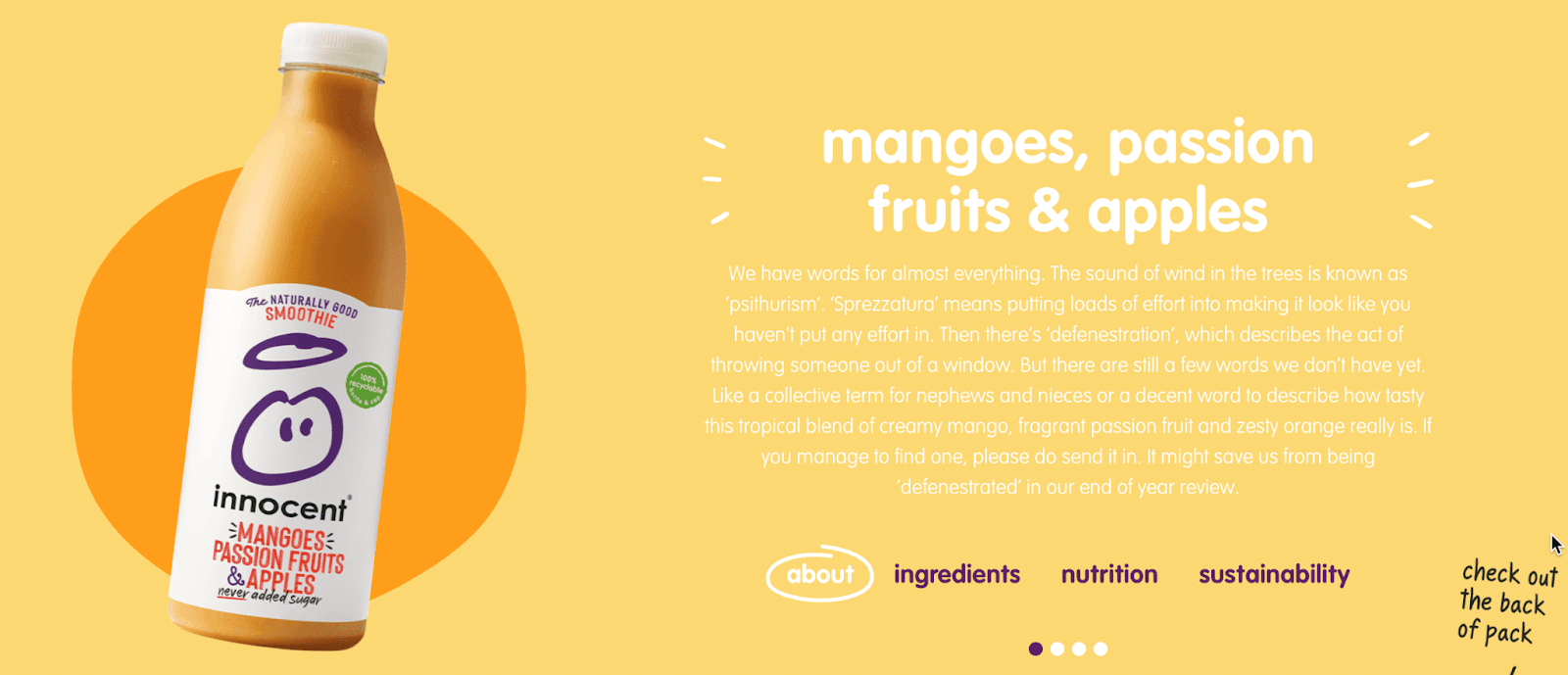The most memorable brands invest in a recognizable, consistent presence, infusing their entire marketing strategy with a distinct personality. But how do they achieve this remarkable feat? Beyond the appeal of captivating logos and eye-catching designs, these brands go a step further by embracing a powerful yet often overlooked element: brand voice and tone.
What Is A Brand Voice?
A brand voice is part of your brand’s unique personality, resonating through every interaction with your target audience across different channels.
Consistency is key here. For instance, if your company uses a friendly and informal tone in its marketing materials, it should maintain the same approach across all brand communications.
The brand voice should stay the same regardless of the different teams managing your company’s social media, email, or website.
Set the direction for your brand voice with the Brand Vision Statement Generator!
Why Is Having A Strong Brand Voice Important?
The most enduring companies have a strong brand personality and a clear sense of purpose. Developing brand recognition with consumers requires consistency and repetition.
If your branding or messaging appears to change frequently, it’s harder for audiences to know exactly what you’re all about. Consequently, your efforts are more likely to lose their impact and be overshadowed by a better-branded alternative.
What Exactly Is The Difference Between Voice & Tone?
In addition to your brand’s voice, it’s also important to understand tone.
- Voice describes your company’s personality. It’s consistent and unchanging.
- Tone is the emotional inflection applied to your voice. It adjusts to what’s suitable for a particular piece or message.
While your voice remains consistent, your tone may change according to the context of your messaging. For example, a social media post about a fun sale would have a more light-hearted tone than one breaking news about a company crisis.
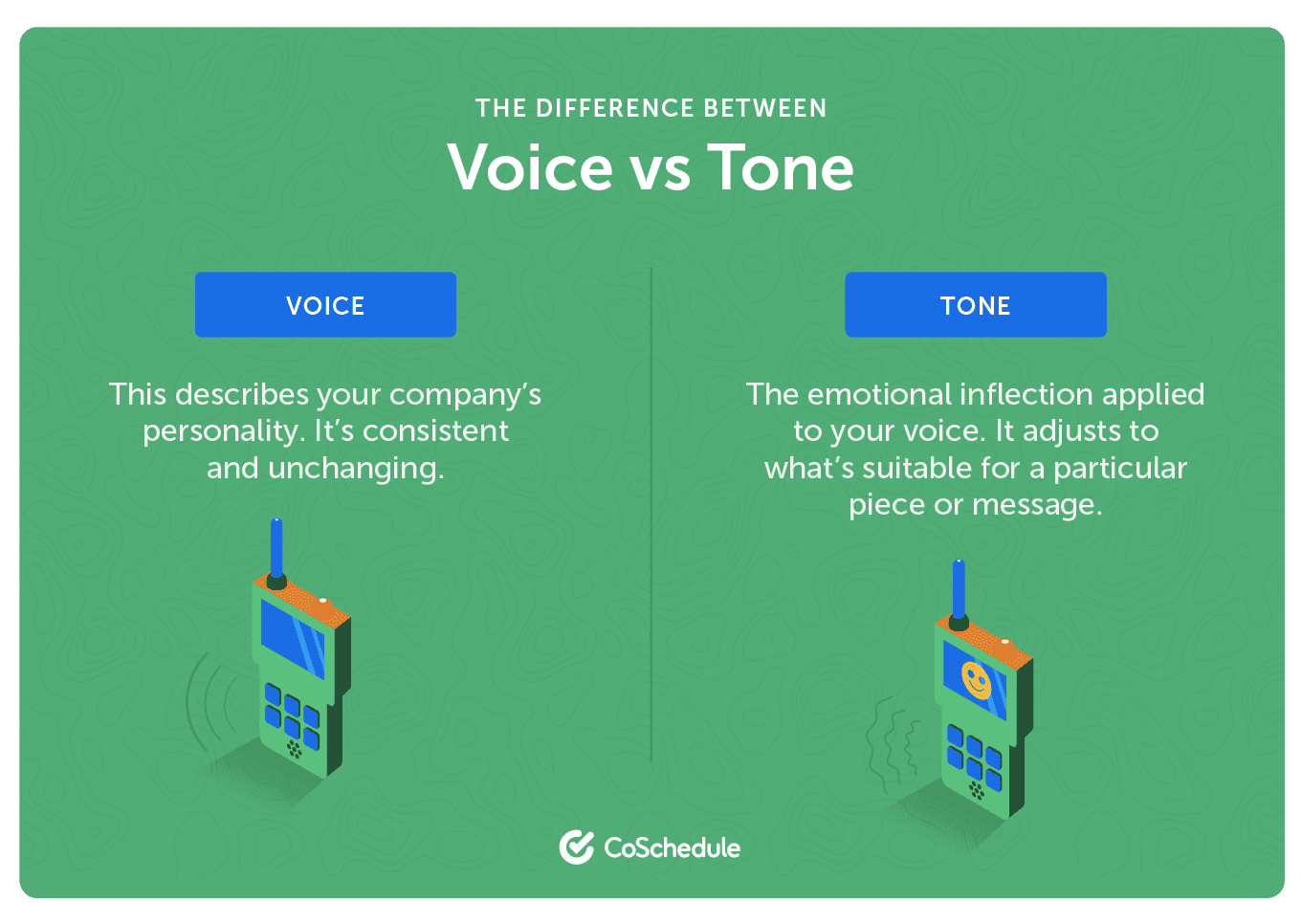
Now to the fun bit! Here are seven easy steps to establish a strong voice for your brand.
Step 1: Review Your Company’s Mission Statement
Your brand’s personality and voice should align with your core values. Your mission statement (or something similar) can be a solid starting point to connect your values with your marketing endeavors.
Look at MailChimp’s mission statement as an example:
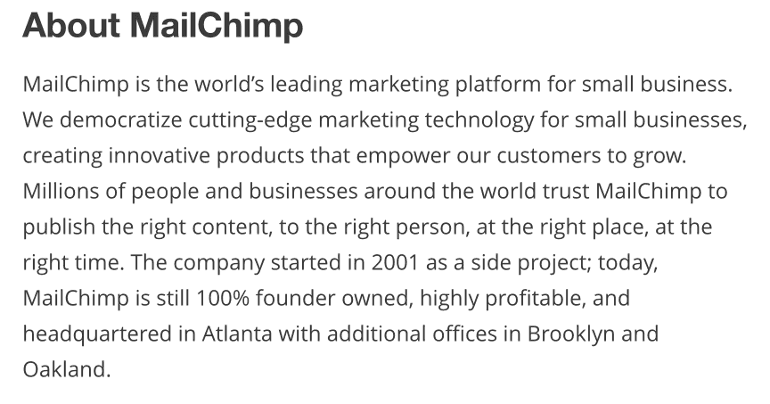
MailChimp’s core focus is helping small businesses succeed. So, it’s no surprise its marketing efforts convey a warm and helpful tone. Here’s how the company describes its voice in its public style guide:
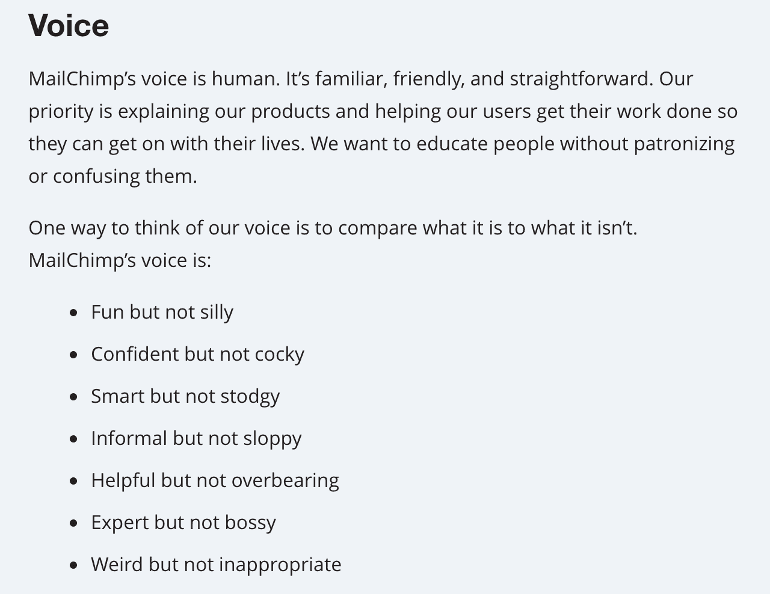
The chosen brand adjectives consistently reflect MailChimp’s commitment to being useful and welcoming.
Step 2: Audit Your Current Content & Messaging
Next, review your existing marketing assets (e.g., website, blog posts, social media posts, print materials, radio ads) to find recurring themes or consistent messaging and tone. Assess if your current voice aligns with your values and brand purpose. If it doesn’t quite hit the mark, think about how you can improve and refine it.
Give special attention to your best-performing pieces. These assets hold valuable insights into what truly resonates with your audience.
Step 3: Research Your Audience
If you have an existing audience, poll them on how they see your brand. Ask questions like:
- How would you describe our brand?
- If our company were a person, what would it sound like?
- Is our tone appropriate in your view?
Another way to understand your target audience is to sample your current best customers and research them. Here’s how it’ll work:
- Select five top customers from your existing clientele.
- Google their names individually.
- Analyze their social media activity to determine their interests, preferred writing style, and reading habits.
If they enjoy comedies, add humor to your brand voice. If they’re into sci-fi, incorporate more nerdy sci-fi puns. Write a list of the words that come to mind as you evaluate each customer. Once you’ve completed this process for every person in the sample, examine the lists to identify shared words or themes.
When we followed this exercise at CoSchedule, we discovered:
- Our target audience: primarily females interested in marketing, yoga, rock climbing, outdoor activities (kayaking, hiking, biking), and classic sports like baseball. Generally, they prefer trendy experiences.
- Their food preferences: local or delivery (take-out), fancy donuts, coffee, kombucha, and craft breweries.
- Their media consumption: Avid readers of snarky/sassy fiction and self-help or self-improvement books. They engage with TED talks, CoSchedule, Pinterest, and Instagram.
This is helpful because your brand voice should feel familiar + similar + natural to your target audience. It should embody a persona they can easily connect with and build a meaningful relationship.
Step 4: Do A ‘We’re This, Not That’ Exercise
To better define your brand, it can be helpful to identify what you are not.
Here’s how to go about this: fill in the blanks in this sentence:
“We’re _______ , but we’re not _______ .”
Repeat this exercise multiple times until you have three or four sentences that accurately capture your brand. Here’s an example of what it could look like:
“We’re confident, but not arrogant.”
“We’re witty, but not snarky.”
“We’re approachable, but not overly casual.”
“We’re innovative, but not gimmicky.”
Step 5: Create A Brand Voice Chart
Now comes the exciting part!
Take the top three to four brand traits that truly represent your unique identity, and complete a chart like the one below, explaining how each trait should and shouldn’t be represented in your marketing:
To make things easy, we’ve provided a handy template.
- In the left column, list your brand’s core traits/characteristics that define who you are.
- Provide a brief explanation of each trait in the next column.
- Then, in the following two columns, explain how to use (and not use) this trait in your marketing efforts.
Once you’re done, the completed template should look something like this:

Keep the template accessible and share it with your writers to ensure your brand voice remains consistent across all your marketing materials. This will keep your team on track and maintain the unique personality that sets your brand apart.
Step 6: Enforce Consistency With Clearly Documented Guidelines
Provide clear guidelines to your team members and coworkers creating content. These guidelines will act as a compass, aligning diverse voices and ensuring a unified brand identity (even when multiple people are creating content and writing copy).
In her extensive article on the CoSchedule Blog, Brittany Berger outlined the following five benefits of documenting and providing accessibility to these guidelines:
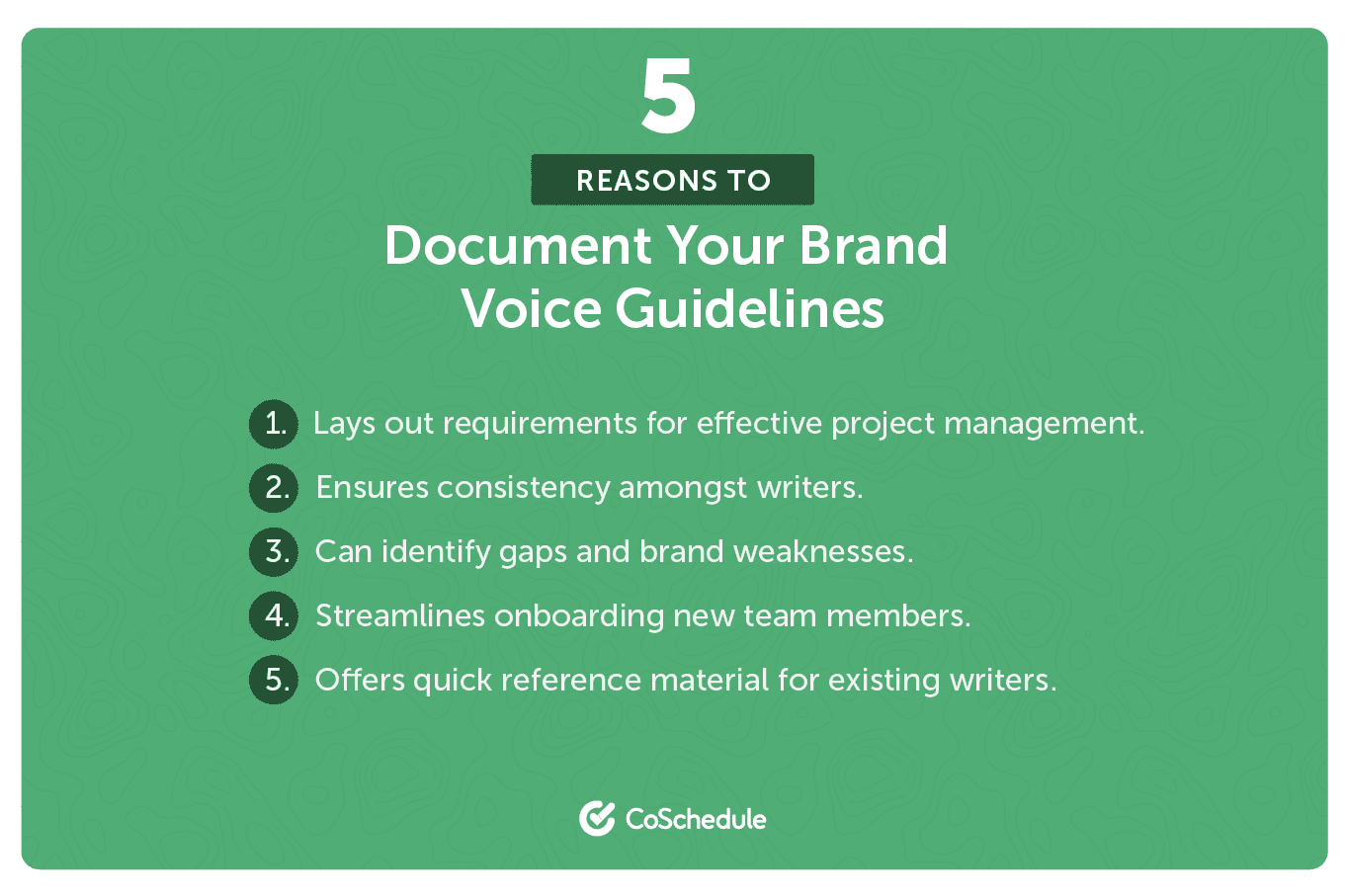
Adapting your tone to different situations is critical. Consider factors like the message, platform, or audience segment you’re targeting.
For instance, a cheerful tone isn’t appropriate when delivering unfortunate news. Similarly, when scripting a how-to video, it’s best to avoid sounding overly formal or serious. Flexibility in your brand tone ensures effective communication in every situation.
MailChimp addresses this with a brief explanation:
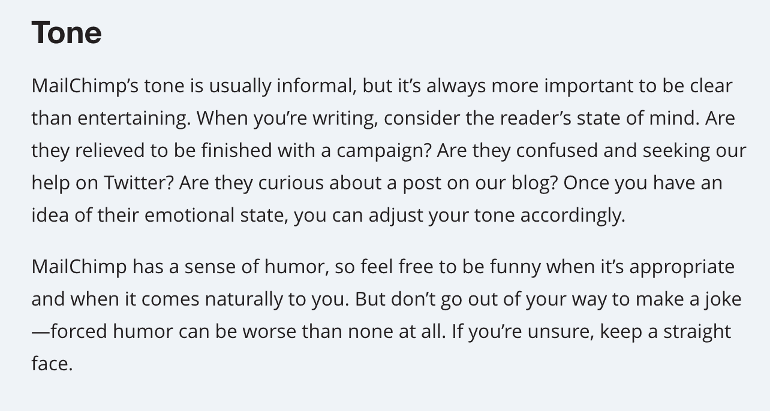
Which Tone For Which Circumstances?
Ready to craft a straightforward explanation for all content and copywriters in your organization? Start by answering this question:
Is our tone generally formal or informal?
From there, determine how your tone might change based on the medium:
- Under normal circumstances, our voice should be [FORMAL/INFORMAL].
- When responding to a customer, adopt a tone that matches the conversation. For example, respond graciously to praise and address complaints with genuine concern.
- When delivering bad news, approach the matter with a serious tone.
Then, provide a concise description of the appropriate tone for writers in various job contexts.
If this still sounds abstract and a little tough to understand, that’s okay. Sometimes, it’s easier to see real-world examples to make a concept click. Here are three brands that have nailed their voice.
Innocent Drinks
Innocent Drinks is a UK-based company known for its smoothies and juices. It has a friendly, playful, and humorous brand voice that resonates with its target audience, showcasing its commitment to healthy and fun living. One example of its voice in action is the witty and light-hearted messaging on its website:
Salesforce
Salesforce, a top-tier customer relationship management (CRM) platform, exudes a professional and authoritative brand voice. Its content revolves around industry expertise and thought leadership, presented with confidence and informativeness. A prime illustration of this is its State of Marketing Report, where Salesforce delves into insightful industry analysis, highlighting evolving trends and emerging challenges in a well-structured, data-driven manner.
Wendy’s
On social media, popular fast-food restaurant chain Wendy’s often unleashes its bold and playful brand voice, engaging in hilarious banter that will leave you in stitches. Just peek at its Twitter account to see it fearlessly dish out witty comebacks, clever wordplay, and cheeky replies to followers and competitors. Here’s a snippet of Wendy’s epic replies to followers on National Roast Day:
Nike
Nike’s brand voice is an embodiment of inspiration and motivation, resonating with a wide audience through its powerful slogan, “Just Do It.” Known for its bold and passionate approach, Nike consistently pushes the boundaries of what’s possible in sports and in life.
This ambitious drive is reflected in their marketing campaigns, which often emphasize perseverance and determination. Nike’s tone of voice is not only about selling products but also about creating a movement and inspiring action.
It’s a call to action that inspires and challenges individuals to push their limits and strive for greatness. That brand voice is shown in this ad below.
Redbull
Red Bull’s brand voice is a powerful expression of its dynamic and adventurous spirit. Known for its iconic slogan “gives you wings,” Red Bull infuses its communication with energy, innovation, and a sense of pushing boundaries.
One of the key strategies in Red Bull’s branding is its association with extreme sports and high-energy activities. Red Bull’s brand voice is a blend of excitement, creativity, and consistency, making it a standout in the energy drink industry and beyond. Check out this example of Red Bulls adventurous spirit:



